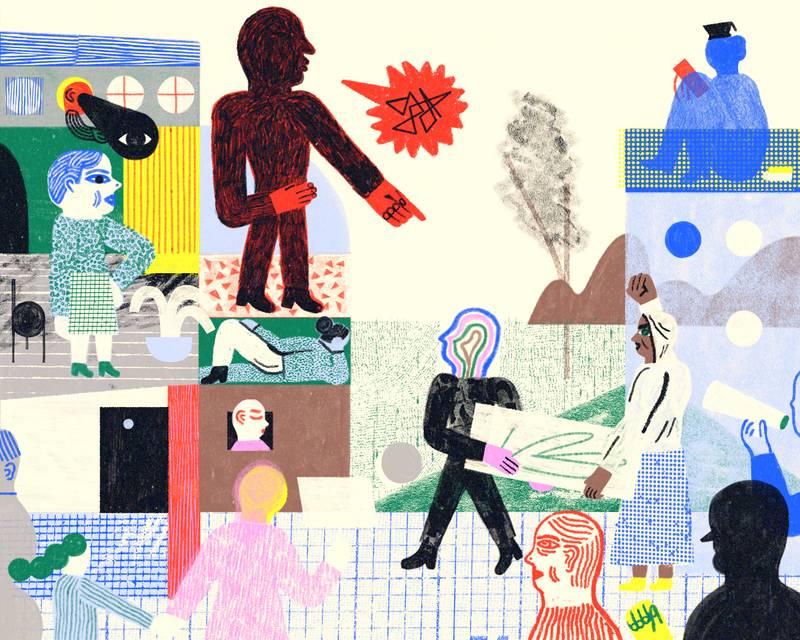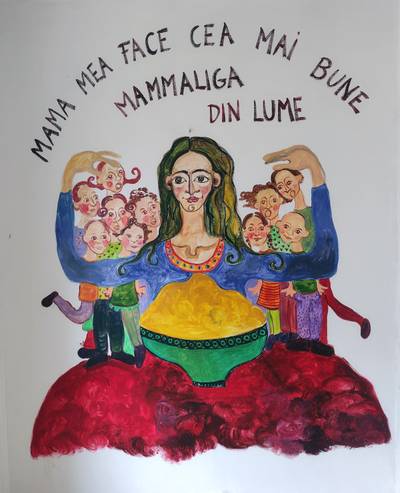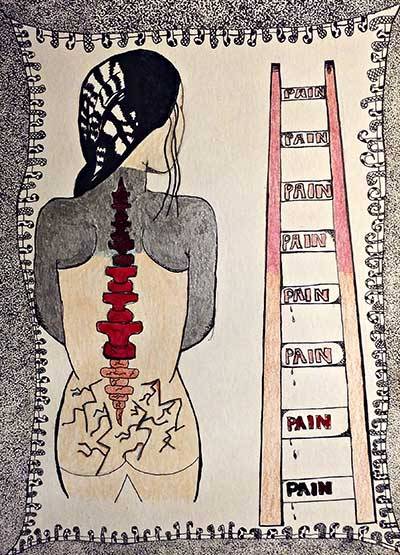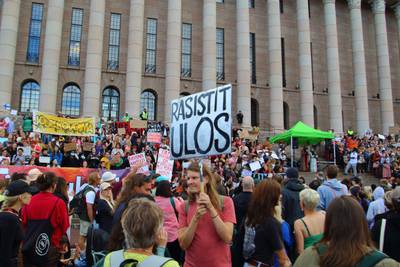

Illustration by Sergey Isakov
Rebecca Close works at the intersection of art, technology and poetry, with a research focus on histories of reproduction and reproductive politics. Their films, ceramic pieces, creative coding experiments and poems often address everyday experiences of the Internet interface, notions of the network and the viral as these intersect and inform sexuality, social relationships, experiences of the familial and access to the commons.
The lyrical “I”
Lyric poems taught me something relevant to artistic research: the “I” is fashioned, styled. In lyric poems, life experiences, social theories, feelings, observations about the changing environment, daily and family life are ciphered through the single point of view of the speaker, who is sometimes, but not always, the poet. Don’t be fooled by the transparency of “I”. In any self-respecting lyric poem “I” is much laboured: the labour laid out for the reader to trace, step by step. In the Romantic (William Blake) or Modernist (T. S. Elliot) lyric, this step by step is key: “I” is a body that paces; “I” moves around as much as “you” the reader, who it is more readily accepted is just passing through. In the work of working-class Romantic poet John Clare, the speaker is always out and about. In his The Progress of Rhyme (1824), “I” rambles in both senses of the word: the English countryside, whose legal enclosures the poet documents and protests, and local birds, whose song the poet transcribes, trigger the unfolding of an extended polemic on the politics of publishing, land rights, homelessness, madness and love.1 The pace of walking and the pace of thinking coincide to determine the captivating music of this poem. It’s my favourite lyric. In Angelina Grimké’s Under the Days (1927), the speaker is rather confined, lying still, in a poem that registers how the capitalist organisation of time manifests as physical pressure on the body: “The days fall upon me; One by one, they fall / Like leaves…./ They are black / They are grey. / They are white; / They are shot through with gold and fire. / They fall, / They Fall / Ceaselessly. They cover me, They crush, They smother. Who will ever find me / Under the days?”2 Despite the wealth of biographic details that may link poem to poet in the lyric tradition, the referent of “I” is rarely fixed. The tense relationship that a poet may have with “I” is sometimes part of what is happening in the poem. If the reader thinks the speaker of Eileen Myles’ An American Poem is the poet because the first line begins with a piece of what we would call in today’s age of digital data protection laws a piece of personally identifying information –“I was born in Boston in 1949” (which is where and when Eileen Myles was really born)– then they will be surprised to learn a few lines down that no, “I am a Kennedy”, and later “We are all Kennedys and I am your president” (Eileen Myles did run for president so this is also not not true).3 The lyric poem, far from speaking truth to identity, observes, plays, drags, morphs it. The racial politics that determines who is pressured or celebrated for presenting an authentic “I” is addressed in Audre Lorde’s Prologue (1971): “Haunted by poems beginning with I […] somewhere in the landscape past noon / I shall leave a dark print / of the me that I am / and who I am not”.4 Fran Lock’s Dispatches from the Bestiary: Here is a list of incorrect things – The Fall, ‘Wings’ (2022) threads maximalist, glitching elegies; with morning pages; with enamoured dedications; with historical research on mediaeval bestiaries; with critical reconstructions of the sexualised figure of the hyena in popular culture.5 These poems institute a joyfully shifty and electrifyingly paranoid “I”, vulnerable to the vicissitudes of changing urban and rural landscapes, representations of the body in science, systems of power, internal and external voices of authority, sexuality, love, religion, and the self’s feral multiplicity. In the same poem, the “I” might be desiring, emptied, knowing, lost, wanting, afraid, in love, assured, connected, abandoned and abject. There is no direction to the madness and no method first. The lyric poem brings it all together in one voice live. This is why I love reading lyric poems: the lyric celebrates the human labour –the pleasure and the stakes– of working “I” as it is profoundly connected to other living beings and entirely informed by things outside of the self: the places where we work or grew up, ancestries, the people we live with, and the past and present political economic conditions of our lives. These things all inflect the self-conscious music of the lyric. Traditionally, the lyric is perceived to be “the personal” at the service of “the universal”. The best lyric poems though take the inverse route: they direct something of the universal experience of having a body that moves through space and time with greater or lesser comfort, at the service of the person. This is the research dimension of the lyric poem: a poem that knows something about the making and maintaining of people. It is a form that registers, as Marxist Feminists would say, social reproduction.
The confessional “I”
In the interdisciplinary field of artistic research “I” is sometimes used to guide the reader from not-knowing to knowing. This is how research is construed within the academy: the pursuit of things we need to know, but do not know yet. The “I” of artistic research, following this construction, recalls the lost-then-found protagonists of Christianity inflected European literature: “Midway upon the journey of our life, I found myself within a forest dark, for the straightforward pathway had been lost” (from the opening lines from Dante’s Inferno (1314)). Being lost, this literature affirms –and it is surely true– is terrible and not having the right information has certainly led to death and disaster. I do not want to vindicate the value of not-knowing or to say how being lost is good. I do want to resist the conception of research as a journey from not-knowing to knowing. The journey fallacy of research reproduces an ambience of “the confessional”, a term used to describe a kind of lyric poem where the speaker of the confessional poem reveals details of the poet’s real life to the reader.6 Different from the lyric poem, the confessional establishes a triangulation between shame, disclosure and forgiveness that connects it to the practice of confession in Catholicism and psychoanalysis. First introduced in the 1950s to describe the poetry of Robert Lowell, Sylvia Plath and Anne Sexton, today the term is used vaguely, and sometimes interchangeably with lyric, life writing, expressive or personal poetry. The U.S. poet Shane McRae reflects on the racial politics of the term “confessional”, as it has been used historically to describe mainly white writers, and also how it is connected in a theological sense to “a fall from grace. And, at least in America, people of color never occupy that position of grace the way that white people do.”7 While there is an important distinction between the two lineages of confession (poet Rachel Zucker notes how “the Freudian notion of illness as being caused by repressed thoughts is antithetical to the Christian notion of thoughts as sinful”8), the claiming of the poem as a site for “speaking the truth” in confessional poetry weighs heavy on the fashioned “I”s of artistic research. The artistic research text, whether theory, diary-like field notes or experimental pastiche, is structured by a revelatory lost-then-found narrative as the researcher moves, seemingly inevitably, from un-knowing to knowing.
While most artist researchers would not state openly that their research goal is to be forgiven, there is a sense in which the reader of the artistic research text is trained to look out for the learning curve, and so perhaps also to absolve the researcher of their previous (re)constructed state of unknowing. A digression: in artistic research we do not call ourselves the “speaker” and “the reader” as we do in the formal situation of the poem. Why not? Many artistic research texts, in the form of PhD theses, research articles and book length publications, have readers. And many artistic research texts, more than the write-ups of other academic scientists, employ expressive, experimental and poetic writing techniques. The question of the speaker of the research has, though, been amply addressed as a question of ethics and method across feminist, decolonial and queer scholarship. I wonder whether the question of “the speaker” in research may also be considered a poetic matter. That is, the “I” of artistic research has both a political (methodological and ethical) and a poetic (lyrical) dimension.
Constructing the “I” of artistic research lyrically may favour the transmission of the circular, polyphonic, constellation-style nature of the non-journey of knowing. The lyrical “I” lifts the confessional weight of the European sciences of psyche and spirit that pressure the speaker of the artistic research text to disclose even the most minor or derailing failures of the project so as to follow the “true” curve of the journey. I confess. I think I have done this myself, and the unsatisfying feeling it left me with is what is driving this text. Another influence was a conversation with the commissioning editors, who responded, when I said I might want to write something about “failure in artistic research”, that “failure is kind of abused in artistic research writing, like ‘I failed at my objectives but on the way I found a flower, O look, so pretty’” (I’m paraphrasing). Last week, I spent an evening trying to get a lover, who has over a decade’s worth of training in Lacanian psychoanalysis, to explain to me why, for the Lacanian, the confession is literally nothing. After much chat and memorized lines from The Seminars (1952-1980), which I now can’t remember, I understood that confession is nil because it would only ever be a beginning. As in, I confess. Ok, Yes…And? I agree and here we are. Still at work.
The lyrical “I” of artistic research sustains an approach to research as not only the search for what we do not know yet, but also the affirming and remembering of what we already know. This is not a new definition of research but one extensively elaborated within the feminist, queer and decolonial research traditions that potentialize what is known for the analytical lens or methodological apparatus of a given research project: concepts like situated knowledge9, lived body10, black feminist standpoint11, strong objectivity12, border-knowledge13, ways of knowing14, and erotic knowledge15 do not feign unknowing. They know hard and remember firm. According to these traditions, “I” do not (only) “research”, “I” “re” (again, back, undoing, against) “search”.
The Auto-“I”
The question of privacy hung on me throughout my recent Doctoral research project on queer reproduction. I wondered daily if I was losing my privacy, and the privacy of the people I love, by bringing us all into research texts. Is Auto-writing radical, or confessional? Expressive or experimental? It could be radical if it resists what Lisa Duggan defined as the new homonormativity: the “reduction of equality to access to the institutions of domestic privacy, the ‘free’ market, and patriotism”.16 The new homonormativity implies the withdrawal of aspects of sexuality and social reproduction struggles behind closed doors, making it difficult to name and protect configurations of daily or familial life that do not follow the legally and culturally protected models (the nuclear, the monogamous etc.). Expressing equality rights in terms of access to private property and consumer privileges also fragments and limits a shared public imagination and memory regarding the forms of cooperative ownership and collective living arrangements that are humanly possible. Capitalism rests on privatization in this double sense: property creation and the withdrawal of certain topics from public discourse. The disclosure of personal experiences in Auto-writing projects is a tool for de-privatizing social reproduction struggles, precisely in the context of the privatizing regimes of the new homonormativity. Works like Gloria Anzaldua’s Borderlands/La Frontera (1987), Audre Lorde’s Zami: A New Spelling of My Name (1982), Paul Preciado’s Testo Junkie (2017), Anne Boyer’s The Undying (2020), Lauren Fournier’s Autotheory as Feminist Practice in Art, Writing and Criticism (2022), Bob Flannagan’s The Pain Journal (2001) or Maggie Nelson’s The Argonauts (2015)–and too many more to name here– all use auto-writing to know about the conditions of social reproduction. These projects are associated with the “autofiction”17 and autotheory because of the way in which the act of writing is shown within the text to be transformative to the subject who is writing. The “I’s” of these Auto-projects, in this sense, share aspects of the confessional: they speak against shame, reclaim disclosure and seek (if not forgiveness) liberation through writing.
Few critics would say, however, in the age of social media, that “sharing” elements of one’s personal life is inherently disobedient. In the afterword to Transgender Marxism (2021), Jordy Rosenberg situates the Auto-trend within a long tradition of Western aesthetic practices through which a “the fantasy of the perfect metabolism of settler bodies […] haunts the contemporary self-reflexivity of literary form – […] (is not the mis-en abysem of bad autofiction the spectre of a book which refers only to itself).”18 The fashioning of a character who can make sense of themselves as they move through the world ultimately affirms racial capitalism’s self-image as a thermostatically self-regulating system: Auto-writing plays out the racialized fantasy that the solution to the Euroamerican crisis of capital accumulation can be resolved on its own terms and within its own borders. It is an alarming reading of the Auto-turn that coincides with adjacent critiques of the trend as “blindingly white”, in reference to the fact that, like the confessional, many of the writers and researchers associated with autofiction are white.19
Critical revisions of the autofictional aspects of novels by writers of colour as early as the 1880s suggests the long history of the deployment of auto-writing as a tool for, on the contrary, critiquing the structures of marginalization that racial capital relies on.20 Also preceding the most recent Auto-trend in theory and fiction is the field of Queer of Color critique and performance studies, where establishing links across the personal and critical has a rich precedent. Jose Esteban Muñoz, for example, “brings in [his] own personal experience as another way to ground historical queer sites with lived queer experience”.21 The intention is “not simply to wax anecdotally but, instead, to reach for other modes of associative argumentation and evidencing”.22
Across the Auto-“I”s mentioned above the character-protagonists are not quite thermostatically self-stabilizing rational subjects but “I’s” that fail to cohere; discontinuous selves that open and close through their implication in precarious social, technological, familial and romantic networks. The attempt to apply generic terms, like “autotheory” or “the confessional”, also forgets that each author developed their own terminology for what they were doing: Audre Lorde (1982) used biomythography, Gloria Anzaldua (1987) coined Autohistoria-teoría (Autohistory-theory) and Paul Preciado named writing as a technology of auto-experimentation. What links these projects is more an unruly interdisciplinarity: the plots are organized around the writers as they use and move with multiple body and knowledge practices, connecting experiences of performance, hormone taking, poetry, philosophy, activism, drugs, sex, sculpture and sickness. The Auto-“I” approximates the “I”s in-flux of the lyrical tradition, where there is a re/productive relationship between “I” and context, identity and practice, body and text.
“I” after the Internet
In the age of the Internet writing critically against the new homonormativity is not only about “de-privatizing” or making “public” the details of one’s private life, because, as Wendy Hui Kyong Chun observes, since the development of the TCP/IP protocol23 “the public/private binary has been supplanted by open/closed”.24 Writing as a post-internet queer socially reproductive form rather practises openness in the same way that data is transmitted “openly” across the web: via the intense stacking of protocols that set strict rules of exchange. The openness of an Auto-text and the openness of data ushered through a TCP/IP protocol are the same to the extent that they have both been heavily worked on across multiple layers: “the openness – or to be more precise the readability – is constructed”.25 This link between the material conditions of a transmission and the Auto-I is at first metaphorical, but it is also material and historical too: you are probably reading this on your laptop or phone, with an assigned IP address and a local port that receives this communication as pre-ordered packets of data, because they have been standardized, tagged and sequenced so that your virtual machine knows how to “read” them. Similarly, if this text appears coherent, or “I” appear as a stable entity, it’s because of the administrative work I have done at the header level to sequence out the parcels. Writing “freely” after the Internet, where freedom means not a total lack of control but “a particular kind of self-conscious control”26 is a kind of resistance generated within the capitalist protological field.
The absent “I”
Some artist researchers have responded to the theological, political and technological pressures that the confessional, auto- or networked “I”s bring by expelling “I”: pure experimentation. The Avant-garde. In these artistic research projects big materials take the place of the personal; the artwork takes the place of “I”. Perhaps a text accompanies the work. But it is not written by the artist. Or rather, the speaker is not the researcher. The speaker is a rock. To return to poetry for a moment, and as poet Cathy Park Hong writes, “The avant-garde’s ‘delusion of whiteness’ is the specious belief that renouncing subject and voice is anti-authoritarian, when in fact such wholesale pronouncements are clueless that the disenfranchised need such bourgeois niceties like voice to alter conditions forged in history”.27 In fact, the poets sustaining the centuries long lyrical tradition have always combined moments of expressiveness with experimentation –personality with a materialist opacity– and so any impulse to either wholly embrace or reject the “I” are somewhat warped by notions of purity that are profoundly sexualised, gendered and racialised. The “I” of feminist, queer and decolonial artistic research sits between a rock and a hard place.
The lyrical artistic research “I”
when unburnt feelings stood before me
the heaviest rain a hail storm
I felt like the roof
beauty smiled at me
friendship the paycheck
as soon as I thought it there she was I even loved her name
I wrote poems for her
my ambition turned to her
the only opinion that existed was hers
but obsession tried to hoist from love
something
all the qualities I liked I couldn’t pick for me
it took a long time to get
that love has nothing to do
with knowing everything
I left her alone so many people have
mistaken love for fame
but they were wrong about the economy
every self-cohering line
all narration love afforded
every act of centering we’re listening
the economy
so sadistically dressed-up
as your ideal parents
exclamations many faces
I basically know everything
desperation I hummed the sound
blazing beauty cruised through
a sweet location fell on me
a falling winter on my face
rest made of sheep’s wool
one thought took me
neat
I mostly married poetry
check on me
be my parent’s voice
it happened not at work but of its scarcity
help me poetry
the way in this town people talk about work
– excerpted from ‘The Procedure of a Feeling’
A lyrical approach to artistic research writing emboldens the layering of critical, historical, theoretical, sociological, poetic and auto-writing and resists the neat narrative curve of research as a journey. The pace of walking and the pace of thinking coincide to determine the music of the research text. There is no direction to the madness and no method first. The lyrical artistic research text brings it all together live. The lyrical approach to artistic research writing celebrates the human labour –the pleasure and the stakes– of making and sharing knowledge, and how knowing only occurs in relation to constellations of people, disciplines, materials, history, birdsong and buzzing routers. Help me poetry / the way in this town people talk about work.







